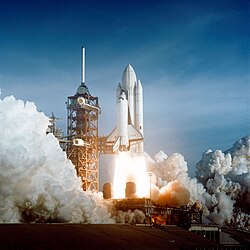STS-33
| Missionsemblem | |||
|---|---|---|---|
 | |||
| Missionsdaten | |||
| Mission | STS-33 | ||
| NSSDCA ID | 1989-090A | ||
| Besatzung | 5 | ||
| Start | 23. November 1989, 00:23:30 UTC | ||
| Startplatz | Kennedy Space Center, LC-39B | ||
| Landung | 28. November 1989, 00:30:18 UTC | ||
| Landeplatz | Edwards Air Force Base, Bahn 04 | ||
| Flugdauer | 5d 0h 6m 49s | ||
| Erdumkreisungen | 79 | ||
| Bahnhöhe | 559 km | ||
| Bahnneigung | 28,45° | ||
| Zurückgelegte Strecke | 3,3 Mio. km | ||
| Mannschaftsfoto | |||
 v. l. n. r. Kathryn Thornton, Manley Carter, Frederick Gregory, John Blaha, Story Musgrave | |||
| ◄ Vorher / nachher ► | |||
| |||
STS-33 (englisch Space Transportation System) ist eine Missionsbezeichnung für das US-amerikanische Space Shuttle Discovery (OV-103) der NASA. Der Start erfolgte am 23. November 1989. Es war die 32. Space-Shuttle-Mission und der neunte Flug der Raumfähre Discovery.
Mannschaft
- Frederick Gregory (2. Raumflug), Kommandant
- John Blaha (2. Raumflug), Pilot
- Story Musgrave (3. Raumflug), Missionsspezialist
- Manley Carter (1. Raumflug), Missionsspezialist
- Kathryn Thornton (1. Raumflug), Missionsspezialistin
Ursprünglich war David Griggs als Pilot der Mission vorgesehen, er kam jedoch während der Vorbereitung beim Absturz seines Oldtimer-Flugzeugs ums Leben und musste durch Blaha ersetzt werden.
Missionsüberblick
Das ursprünglich vorgesehene Startdatum vom 20. November konnte nicht eingehalten werden, weil Teile der Elektronik der Feststoffraketen ausgewechselt werden mussten. Erstmals seit der Challenger-Katastrophe des Shuttle-Programms startete man wieder nachts.
STS-33 war die fünfte Mission im Auftrag des US-Verteidigungsministeriums. Zweck und Zielerreichung unterlagen deshalb der Geheimhaltung.
Die Landung erfolgte am 27. November in Edwards AFB, Kalifornien. Discovery wurde sieben Tage später mittels eines Spezialflugzeuges nach Cape Canaveral, Florida zurücktransportiert.
Siehe auch
- Liste der Space-Shuttle-Missionen
- Liste der bemannten Raumflüge
- Liste der Raumfahrer
- Bemannte Raumfahrt
Weblinks
- NASA-Missionsüberblick (englisch)
- Videozusammenfassung mit Kommentaren der Besatzung (englisch)
- STS-33 in der Encyclopedia Astronautica (englisch)
- Michael Cassutt: Secret Space Shuttles (englisch)
Auf dieser Seite verwendete Medien
STS-33 Mission Insignia
On November 22, 1989, at 7:23:30pm (EST), 5 astronauts were launched into space aboard the Space Shuttle Orbiter Discovery for the 5th Department of Defense mission, STS-33. Photographed from left to right are Kathryn C. Thornton, mission specialist 3; Manley L. (Sonny) Carter, mission specialist 2; Frederick D. Gregory, commander; John E. Blaha, pilot; and F. Story Musgrave, mission specialist 1.
The April 12 launch at Pad 39A of STS-1, just seconds past 7 a.m., carries astronauts John Young and Robert Crippen into an Earth orbital mission scheduled to last for 54 hours, ending with unpowered landing at Edwards Air Force Base in California.



